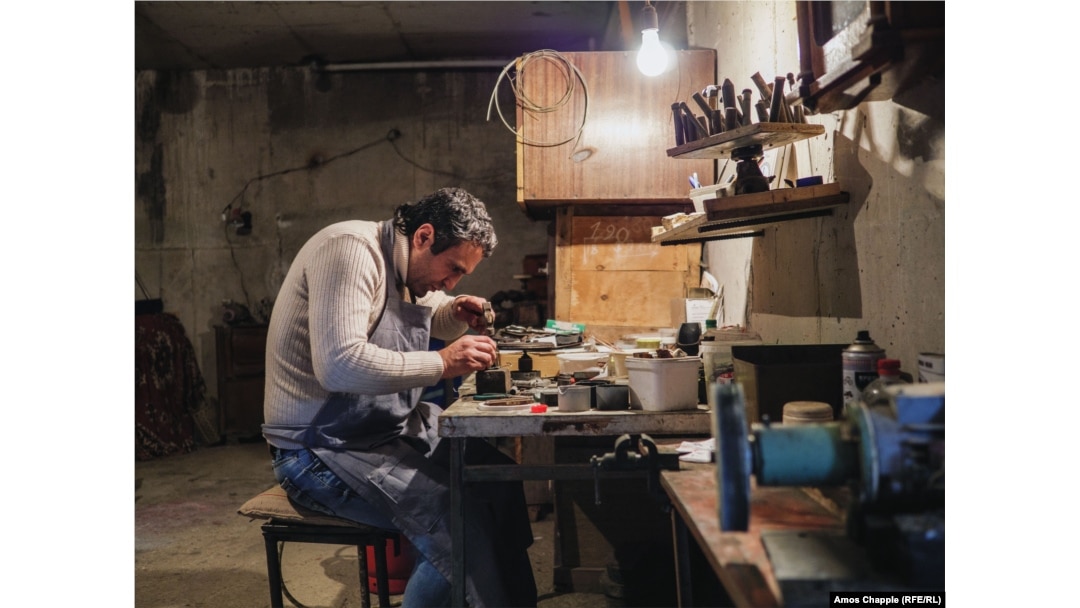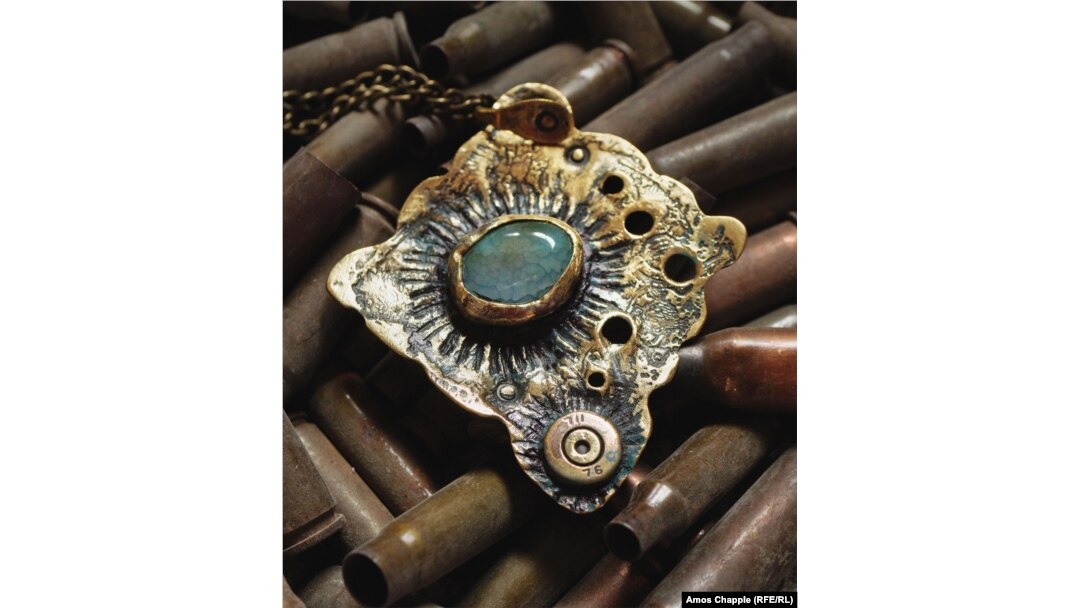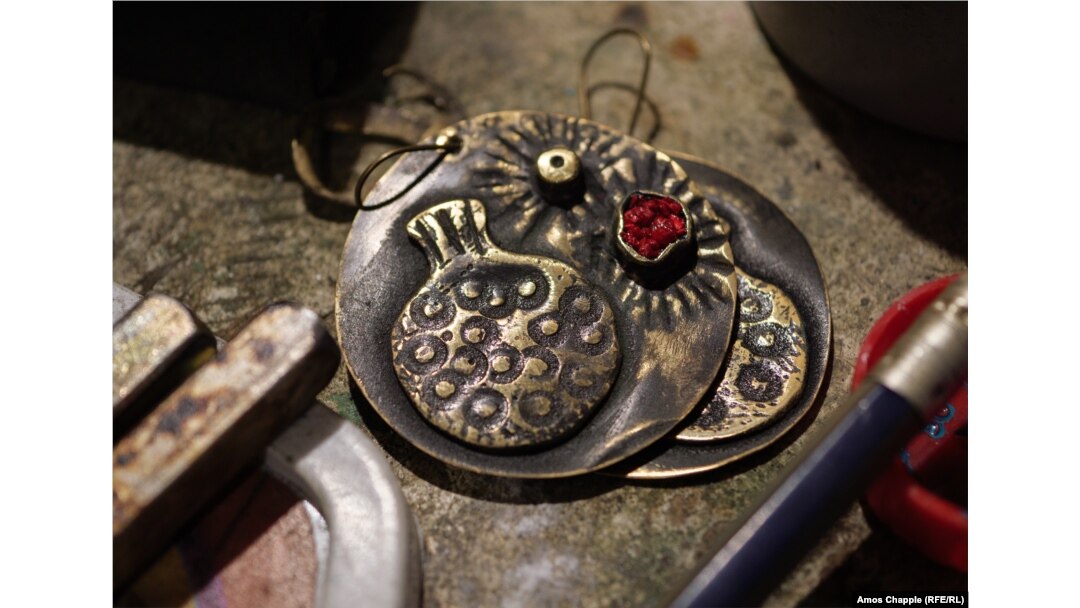
This is Artak Tadevosian, at work on his latest, tiny creation in his basement workshop in Gyumri, Armenia’s second city.

This pendant was made from Kalashnikov bullet casings.
The 40-year-old jeweler works the scraps of combat -- from sniper bullets to shards of grenades -- into exquisite pieces of wearable art.

These pomegranate-themed earrings were fashioned from a bullet and autocannon ammunition.
This crucifix pendant was crafted from a sniper round.
Tadevosian got the idea of making jewelry from weaponry in 2015, when he was unemployed after returning from Russia to his largely impoverished hometown.
While walking with his wife through the mountains surrounding Gyumri, he found piles of bullet casings left over from a military exercise. The city is home to a military base built during the Soviet era that now houses thousands of Russian troops.
Assorted bullet casings -- the raw material for his work -- waiting in Tadevosian’s workshop
When Tadevosian took some of the bullets home, his young daughters asked what the strange objects were used for. After struggling to explain the concept of things designed to kill people, Tadevosian says he vowed to his girls he would turn the bullets “into something positive, something beautiful.”
The jeweler saws off the cap of a bullet casing.
This is the first step in turning a bullet into jewelry. Next, Tadevosian usually cuts the bullet casing open, then hammers and melts it into shape.
A nearly completed earring made from a bullet that was shaped into a gingko leaf. Tadevosian’s thumb was injured by mishaps with his hammer.
Tadevosian says he used to draw plans for designs he hoped to make, but “things never turned out how I sketched them, so now I just make it up as I go along.”
The jeweler holds assorted bullet casings and a finished pendant.
The Gyumri local says the materials of the different weaponry are "quite difficult to work with, but I’ve tried to adapt and have built my own tools to suit the metals. One kind of metal might melt very easily, another might not melt at all. Every weapon is made differently, so it needs a different approach.”
A bracelet featuring the Orthodox Christian cross, cut from a spent artillery shell
Tadevosian says he is now well-known enough in Gyumri that the Russian military base and local police give him the waste from their training.
A crucifix etched with a dove of peace
Tadevosian says his work’s underlying message of peace is aimed at international terrorism “and those who try to reach their goals through the killing of innocents.”
A brooch with traditional Armenian patterns that was made from a bullet casing
Tadevosian says each piece takes at least two to three days and some have taken more than a month to complete.
A bejeweled ring made from a 9mm pistol round
Prices for the jewelry range from 10,000 Armenian drams ($20) to as much as 500,000 drams ($1,000). He sells to buyers in Armenia as well as mostly ethnic Armenian diaspora in Europe and the United States.
A bird fashioned from bullets
Ethnic tensions in the Nagorno-Karabakh region between Christian Armenians and their Muslim Azerbaijani neighbors simmered for decades before the current war broke out on September 27.
The region is recognized as part of Azerbaijan, but ethnic Armenians there reject Azerbaijani rule. They have been governing their own affairs, backed by Armenia, since Azerbaijan's troops were pushed out in a war that ended in the 1990s.
A ring made from bullets
The bleak reality of the conflict was witnessed during RFE/RL’s time with Tadevosian. While shooting photos of the jeweler at work on October 27, he was suddenly called into the yard. Three brothers -- his childhood friends -- were there to say goodbye.
The brothers, who lived in Nagorno-Karabakh, had dropped off their wives and children in Gyumri and were on their way back to fight on the front line. As Tadevosian’s mother fought back tears, the men kissed, joked, and vowed they would all be “dancing and partying at our homes [in Nagorno-Karabakh] soon.”
The jeweler holds a crucifix made from a sniper round.
"We are all soldiers in our own way for our country. Not by fighting with weapons, but by doing our jobs to the best of our ability," Tadevosian says.
"We are a people of culture. Making masterpieces is also a kind of fight.” But, he said, as he shrugged his shoulders, “If the time comes and they need me on the front line, then I’ll go there, too.”


